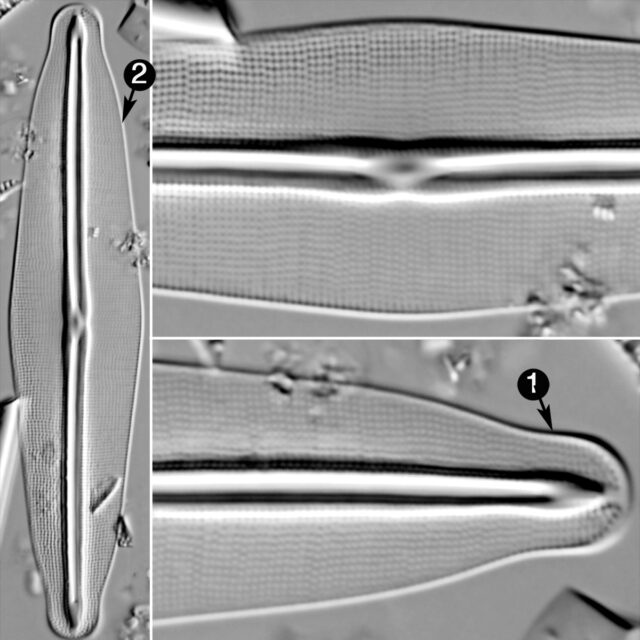Frustulia quadrisinuata
-
Category
-
Length Range58.0-67.0 µm
-
Width Range14.0-15.0 µm
-
Striae in 10 µm30-31
-
ContributorCarrie Graeff - Apr 2012
-
ReviewerMarina Potapova - Jun 2012
Identification
Description
Valves are rhomboid with moderately rounded, protracted apices. The valve margins are moderately undulate. The longitudinal ribs and raphe are moderately curved. The ribs are moderately constricted at the central nodule. Wavy longitudinal striae are present. The striae are parallel at the valve center and transition to slightly convergent well before the apices. The longitudinal ribs and helictoglossae fuse to form a relatively small porte-crayon.
The stria density range of specimens shown here from Utah and Oregon is slightly higher than that recorded in the original description.
The nature of the striae at the apices of F. quadrisinuata is unclear from the literature. In the original description (Lange-Bertalot and Metzeltin 1996, pp. 59-60) the striae are characterized as interrupted at the apices. In later observations, Lange-Bertalot (2001, p. 171) the striae are said to circumradiate the apices. Original light micrographs suggest that the character is variable (Lange-Bertalot and Metzetin 1996, pl. 38, figs 10-12), but Lange-Bertalot does not comment on the discrepancy between the descriptions and figures. Our specimens from Utah and Oregon exhibit show variability of the striae at the apices.
Pishkun Reservoir, Teton Co., Montana (U of Colorado Kociolek Collection, COLO#2383) has a population of Frustulia that is morphologically similar to F. quadrisinuata. The valves are nearly identical, except that they are 1-2 µm more narrow and all specimens were observed to have interrupted striae at the apices. Further investigation will be necessary to determine whether the population from Montana represents a separate species from those in Utah and Oregon.
Citations & Links
Citations
Links
Cite This Page
Graeff, C. (2012). Frustulia quadrisinuata. In Diatoms of North America. Retrieved April 23, 2024, from https://diatoms.org/species/frustulia_quadrisinuata
Responses
The 15 response plots show an environmental variable (x axis) against the relative abundance (y axis) of Frustulia quadrisinuata from all the stream reaches where it was present. Note that the relative abundance scale is the same on each plot. Explanation of each environmental variable and units are as follows:
ELEVATION = stream reach elevation (meters)
STRAHLER = distribution plot of the Strahler Stream Order
SLOPE = stream reach gradient (degrees)
W1_HALL = an index that is a measure of streamside (riparian) human activity that ranges from 0 - 10, with a value of 0 indicating of minimal disturbance to a value of 10 indicating severe disturbance.
PHSTVL = pH measured in a sealed syringe sample (pH units)
log_COND = log concentration of specific conductivity (µS/cm)
log_PTL = log concentration of total phosphorus (µg/L)
log_NO3 = log concentration of nitrate (µeq/L)
log_DOC = log concentration of dissolved organic carbon (mg/L)
log_SIO2 = log concentration of silicon (mg/L)
log_NA = log concentration of sodium (µeq/L)
log_HCO3 = log concentration of the bicarbonate ion (µeq/L)
EMBED = percent of the stream substrate that is embedded by sand and fine sediment
log_TURBIDITY = log of turbidity, a measure of cloudiness of water, in nephelometric turbidity units (NTU).
DISTOT = an index of total human disturbance in the watershed that ranges from 1 - 100, with a value of 0 indicating of minimal disturbance to a value of 100 indicating severe disturbance.

Frustulia quadrisinuata
- Apices protracted and moderately rounded
- Margins moderately undulate
The valve apices are protracted and moderately rounded. The valve margins are moderately undulate.
 Diatoms of North America
Diatoms of North America





